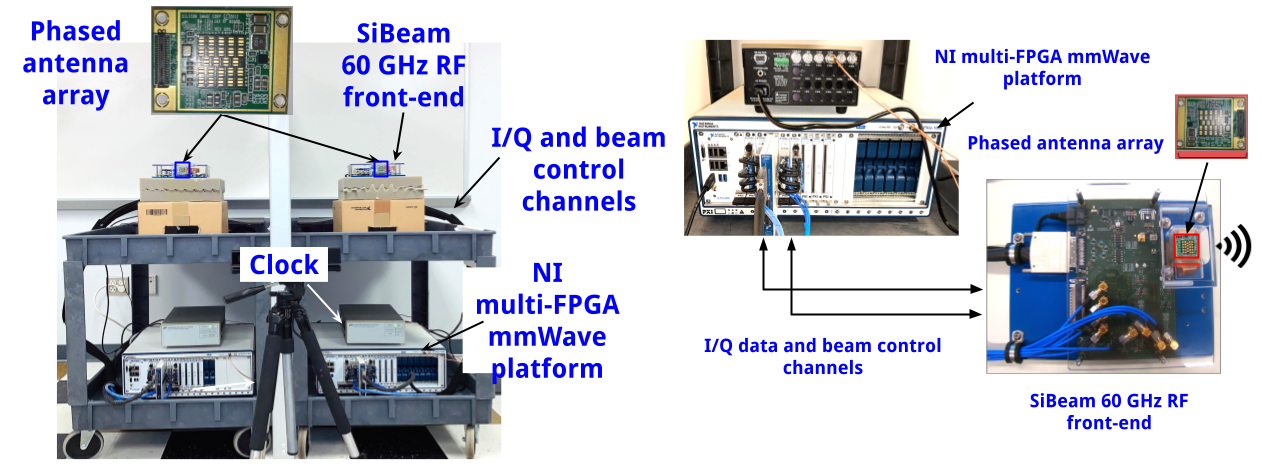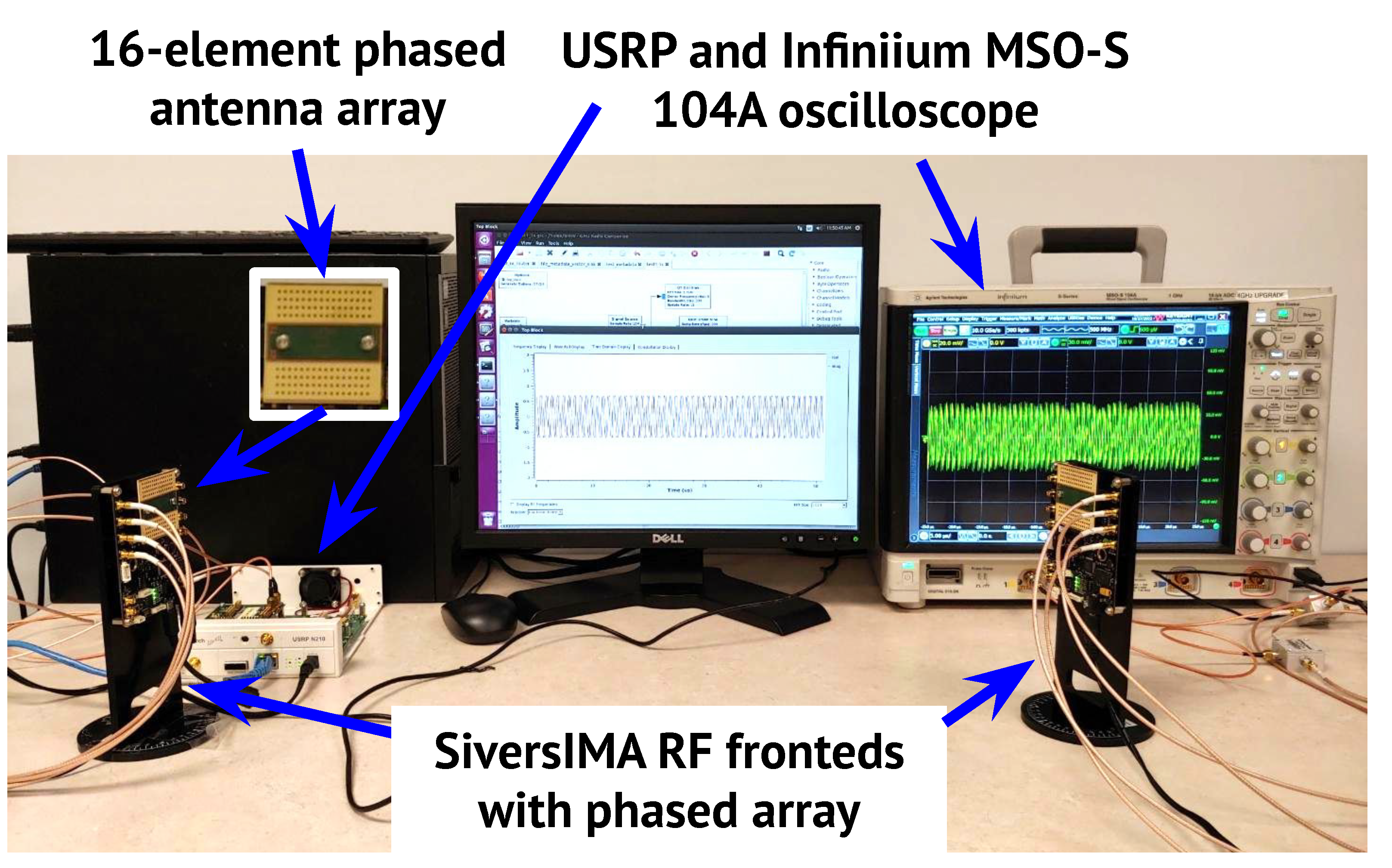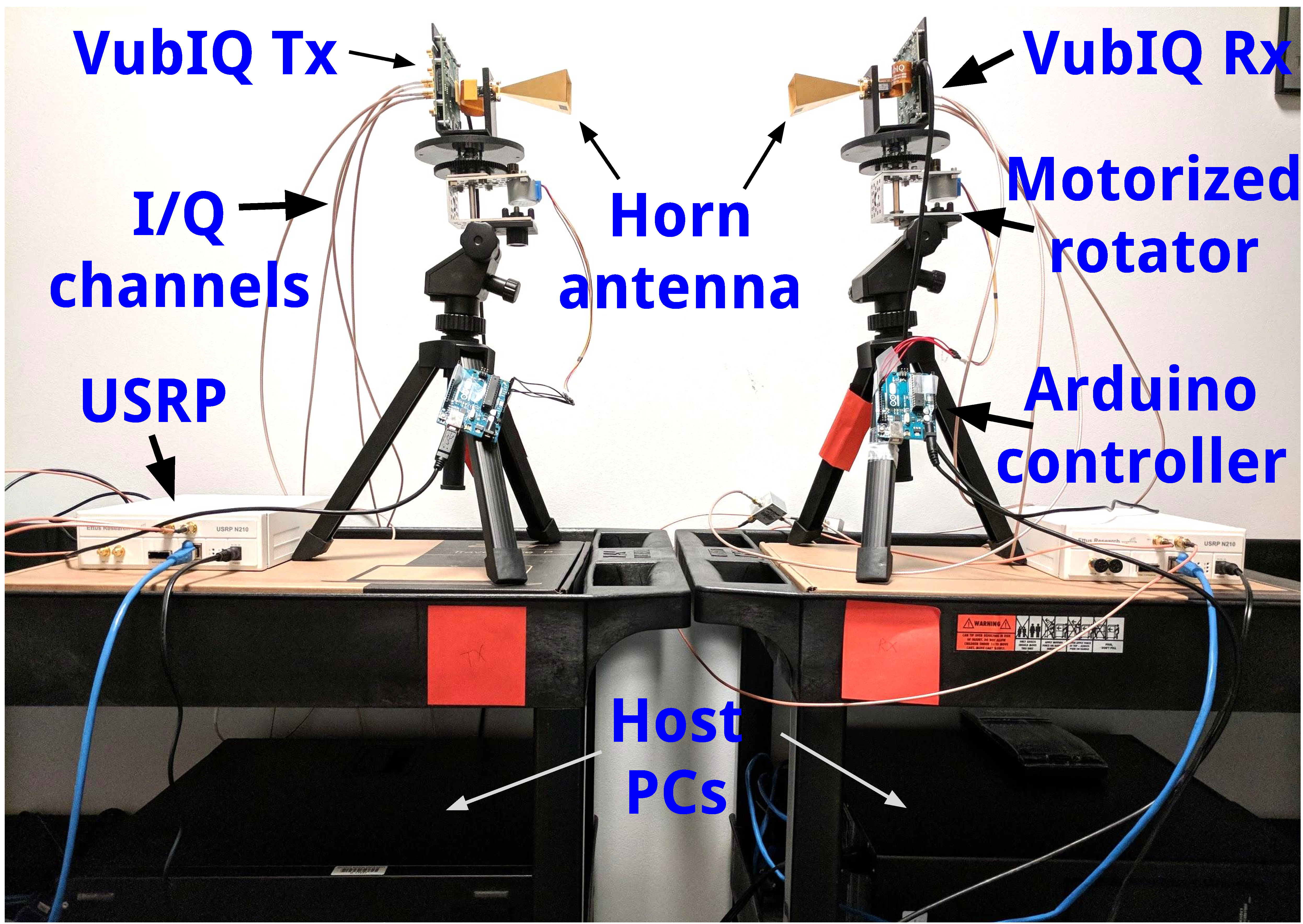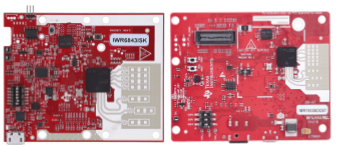Mason-Milli: A State-of-the-art mmWave Networking and Sensing Testbed
The major goal of this project is to design a state-of-the-art, programmable and reconfigurable millimeter-wave wireless networking infrastructure at George Mason University to enable millimeter-wave wireless networking and sensing research. The testbed consists of a range of programmable and reconfigurable devices and their software counterparts.
(1) NI+SiBeam software radio system
 This is a modular, reconfigurable 60 GHz testbed using National Instrument’s multi-FPGA platform integrated with SiBeam’s phased antenna array. The system is developed using a baseband transmitter module (consists of NI PXIe 7902 FPGA and PXIe 3610 DAC modules) and receiver module (PXIe 7902 FPGA and PXIe 3630 ADC), providing multi-FPGA processing. This NI backend system is interfaced with a SiBeam V-band transceiver evaluation board as the RF frontend. The SiBeam platform provides 24 antenna elements (12 for transmitting and 12 for receiving) and capability to perform analog beamforming. The transceiver can provide 1.76 GHz of RF bandwidth at two carrier frequencies (60.48 and 62.64 GHz), and up to 16 QAM modulation for over 3 Gbps of data rate. The default SiBeam codebook includes 25 beam sectors with 3-dB beamwidth of 25 to 30 degrees.
This is a modular, reconfigurable 60 GHz testbed using National Instrument’s multi-FPGA platform integrated with SiBeam’s phased antenna array. The system is developed using a baseband transmitter module (consists of NI PXIe 7902 FPGA and PXIe 3610 DAC modules) and receiver module (PXIe 7902 FPGA and PXIe 3630 ADC), providing multi-FPGA processing. This NI backend system is interfaced with a SiBeam V-band transceiver evaluation board as the RF frontend. The SiBeam platform provides 24 antenna elements (12 for transmitting and 12 for receiving) and capability to perform analog beamforming. The transceiver can provide 1.76 GHz of RF bandwidth at two carrier frequencies (60.48 and 62.64 GHz), and up to 16 QAM modulation for over 3 Gbps of data rate. The default SiBeam codebook includes 25 beam sectors with 3-dB beamwidth of 25 to 30 degrees.
(2) USRP+Sivers/VubIQ system


This testbed includes 4 links (8 endpoints) where each endpoint includes a USRP N210/X310 as baseband processor and SiversIMA 60 GHz (and 28 GHz) RF frontend with phased array or VubIQ RF frontend with horn antenna. The Sivers 60 GHz RF frontend has two phased antenna arrays (one for sending and the other one for receiving) with 64 antenna elements each. We use the default codebook from Sivers with 63 beams where the mainlobe angle of every beam is approximately every 1.5 degrees in azimuth. The VubIQ platform uses multiple horn antenna (3 and 12 degrees) along with Arduino powered motorized controller for mechanical beamforming.
(3) COTS 802.11ad/ay mmWave WiFi devices
 Our COTS testbed includes 24 802.11ad devices (10 from Airfide and Microtik, remaining are Acer laptops, TP-Link Talon and Netgear routers) and 6 802.11ay devices (MikroTik). Each 802.11ad device is equipped with Qualcomm QCA9500 chipset connected with 32-element phased antenna array. The Airfide radios are equipped with 8 phased antenna arrays (each with 32 antenna elements). The patches can be positioned in different directions. The devices provide full networking stack and are capable of creating end-to-end mmWave wireless links.
Our COTS testbed includes 24 802.11ad devices (10 from Airfide and Microtik, remaining are Acer laptops, TP-Link Talon and Netgear routers) and 6 802.11ay devices (MikroTik). Each 802.11ad device is equipped with Qualcomm QCA9500 chipset connected with 32-element phased antenna array. The Airfide radios are equipped with 8 phased antenna arrays (each with 32 antenna elements). The patches can be positioned in different directions. The devices provide full networking stack and are capable of creating end-to-end mmWave wireless links.
(4) mmWave FMCW radar sensors
 Mason-milli also includes over a dozen mmWave FMCW radars (from Texas Instruments) operating at 60 GHz and 77 GHz. These radars have multiple antenna (3 transmit and 4 receive) with 4 GHz of bandwidth. The sensors perform range estimation using FMCW chirps and velocity estimation based on Doppler and phase measurements. They can also perform angle-of-arrival measurement using multiple receive antenna. The on-board DSP outputs a 3D point cloud as well as range-velocity heatmaps. In Mason-milli, the radars are integrated along with RGB-D cameras on various platforms including vehicles, UGVs and UAVs.
Mason-milli also includes over a dozen mmWave FMCW radars (from Texas Instruments) operating at 60 GHz and 77 GHz. These radars have multiple antenna (3 transmit and 4 receive) with 4 GHz of bandwidth. The sensors perform range estimation using FMCW chirps and velocity estimation based on Doppler and phase measurements. They can also perform angle-of-arrival measurement using multiple receive antenna. The on-board DSP outputs a 3D point cloud as well as range-velocity heatmaps. In Mason-milli, the radars are integrated along with RGB-D cameras on various platforms including vehicles, UGVs and UAVs.
Project Support
The project is funded by NSF CRI grant (CNS-1730083) and DoD ARO DURIP 2022 grant.